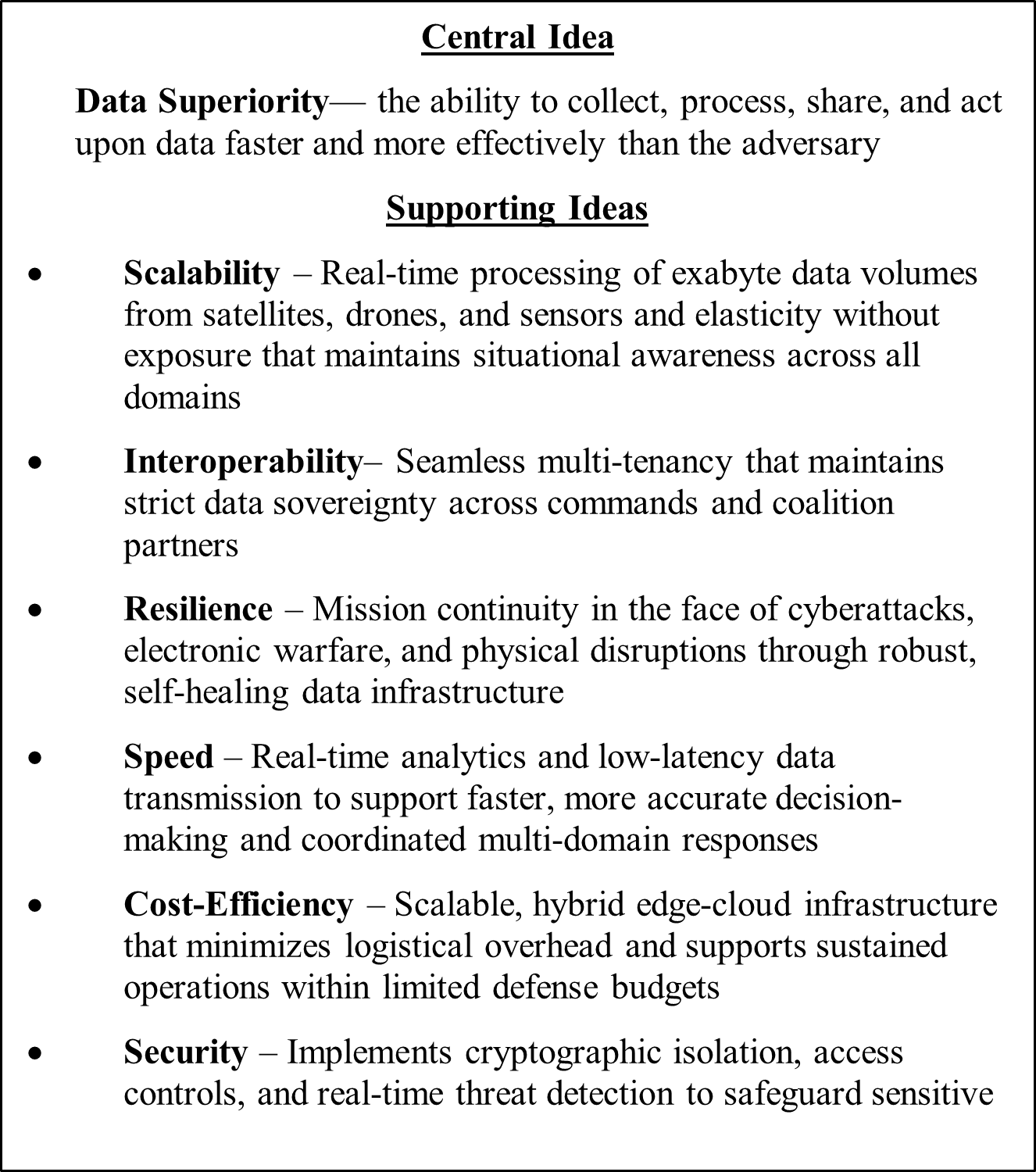“Victory smiles upon those who anticipate the change in the character of war, not upon those who wait to adapt themselves after the changes occur.” Giulio Douhet, Air Power Theorist “The future belongs to those who can collect, process, and analyze data faster and more intelligently than their competitors.” Bernard Marr, Futurist and Author Introduction The battlefield has always … Read more The post Data as Firepower: An Exploration of Data Superiority as a Warfighting Concept appeared first on Small Wars Journal by Arizona State University.
“Victory smiles upon those who anticipate the change in the character of war, not upon those who wait to adapt themselves after the changes occur.”
Giulio Douhet, Air Power Theorist
“The future belongs to those who can collect, process, and analyze data faster and more intelligently than their competitors.”
Bernard Marr, Futurist and Author
Introduction
The battlefield has always been shaped by information. From the scouts of antiquity through today, the side with better knowledge often held the advantage. In today’s operational environment, however, military art has entered a fundamentally new phase—one where data itself has emerged not merely as an enabler but as a key warfighting capability, one that can potentially turn the tide of a battle, operation, or even an entire campaign.
Some projections put the sum total data in the world at 181 Zettabytes and growing at 2.5 quintillion bytes a day. As a result of this exponential growth, the concept of data superiority—the ability to collect, process, and act upon data faster and more effectively than an adversary, bears a deeper investigation. This article argues that data superiority is now essential for achieving tactical and operational advantage and ultimately unlocking strategic success.

The US Army’s vision for 2040 emphasizes achieving decision advantage through enhanced information processing, data-driven insights, and the integration of advanced technologies like AI and autonomous systems. Data superiority and decision advantage are closely related but serve different roles. Data superiority emerges as the critical capability and it is the precursor of decision advantage. Data superiority focuses on the ability to access, move, process, and exploit raw data at speed and scale. Decision advantage enables commanders to consistently make and implement better, faster decisions than the adversary. Simply put, decision advantage can determine operational success, but without data superiority makes decision advantage difficult, if not impossible.
This is because advanced data systems such as AI, autonomous platforms, and real-time targeting tools rely on vast volumes of raw data delivered in real time, and not on processed information. Combined with human judgement, data superiority can enable capabilities to function at machine speed, outpacing adversary decision cycles. It also supports interoperability across joint and coalition forces, improves resilience against cyber and electronic attacks, and allows for decentralized, adaptive responses. As modern conflict increasingly depends on data-rich, fast-moving environments, the ability to control and leverage raw data streams becomes an imperative—making data superiority a prerequisite for achieving information superiority.
The Lessons of History
The pursuit of timely and relevant information has always been essential to effective command. George Washington was renowned for establishing an organized intelligence network, including the Culper Spy Ring, to gain advantage during the Revolutionary War. Similarly, Napoleon Bonaparte frequently conducted personal battlefield reconnaissance to make informed decisions, often positioning himself at the front lines to assess terrain and enemy positions. What has changed, however, is the scale and velocity of information. In today’s world, data is growing at an exponential rate—from satellite feeds to cyber telemetry—and the ability to process, fuse, and act on that data at scale has become a defining feature of modern military advantage. The challenge isn’t just acquiring information, but managing the vast volume, variety, and velocity of it, all in real time.
Without question, air superiority was a defining factor in World War II. Once the Allies gained control of the air, they disrupted German logistics, crippled industrial capacity, and protected their own ground forces. Air dominance allowed for faster, more flexible, and more precise operations—establishing it as an enabler of victory. Today, data superiority plays an analogous role. On the digital battlefield, whoever controls the flow of information—collects it effectively, analyzes it in real time, and shares it across domains—gains an advantage.

Air Superiority was vital in WWII, Data Superiority is emerging as critical factor in contemporary conflict
In many ways, data has always played a role in key military conflicts. During World War II, Allied success in deciphering the Enigma code gave commanders operational insight that often shifted the course of battle. Similarly, Operation Desert Storm integrated satellite Intelligence, Surveillance, and Reconnaissance (ISR), nascent Global Positioning Systems (GPS) at the tactical level, and emerging digital command systems, illustrating the power of real-time data in joint warfare . Arguably, the devastating precision of the U.S.-led coalition’s attack along the “Highway of Death” during the Gulf War starkly illustrated the power of a data-driven approach to warfare. This marked a turning point where data fusion and precision engagement reshaped the battlefield, demonstrating how information can translate directly into tactical and strategic superiority.
These historical examples highlight a clear trajectory: as warfare evolves, so has the centrality of technology and data as a key enabler. The ability to harness data has become not just a supporting function but a core element of combat power—raising important theoretical questions about the nature of decision-making, deterrence, and domain integration in the information age.
Theoretical Foundations: From Boyd to Byte
Understanding data superiority requires revisiting some foundational military theory. Clausewitz’s classic notions of fog and friction also take on new digital dimensions. Modern militaries face a paradox of complexity: while data networks can reduce uncertainty, they also risk overwhelming decision-makers with disjointed or misleading inputs. As such, the imperative is not to simply gather more data but to derive clarity and meaning from it. Simply put, this is what commanders at all levels are paid to do.
The OODA Loop—Observe, Orient, Decide, Act—introduced by Air Force Colonel John Boyd, remains highly relevant. Boyd argued that decision dominance stems from the ability to cycle through these four stages faster than the adversary. In the digital age, data is the substrate of this loop. Speed and accuracy in observation and orientation depend directly on a force’s ability to harness and synthesize vast datasets. At the global scale, the OODA Loop becomes not just a tactical or operational framework, but a strategic imperative for entire military organizations. Although Boyd’s model is simplistic and arguably most applicable at the tactical level, without question contemporary militaries operating across multiple theaters and domains are challenged to integrate large amounts of data from satellites, cyber operations, electronic warfare, and human intelligence to maintain decision superiority.

Boyd’s OODA Loop (Image: https://en.wikipedia.org/wiki/OODA_loop)
Contemporary Conflicts and the Role of Data Superiority
In the 2020s, the concept of data superiority—the ability to collect, process, and act on data faster and more effectively than the adversary—has become a defining factor in modern warfare. Nowhere is this more evident than in the wars in Ukraine and the most recent Israeli conflicts.
In Ukraine, the war has become a proving ground for integrating commercial and military data streams in near real-time. Ukrainian forces, supported by Western intelligence and commercial satellite providers like Maxar and Planet, have leveraged geospatial data (GEOINT), drone feeds, and social media scraping to anticipate Russian movements and adjust tactics accordingly. Western nations have provided not just weapons, but also cloud-based battlefield management tools that enable decentralized command and rapid targeting decisions. The successful use of systems like Delta, Ukraine’s real-time command and control platform, underscores how digital infrastructure can compensate for numerical inferiority with superior situational awareness rooted in data dominance.
The Israeli Defense Forces (IDF) have similarly emphasized data fusion and AI-driven targeting in their operations against Hamas and Hezbollah. The IDF’s use of real-time surveillance, signals data, and AI-assisted target recognition systems has enabled rapid kill chains and precision strikes on high-value targets embedded within dense urban environments. IDF capabilities increasingly rely on a blend of military-grade sensors and commercial data analytics, creating what some analysts have described as “algorithmic warfare.” This form of conflict rewards those who can integrate disparate data sources into a coherent, actionable picture faster than their opponents.
Both cases illustrate that data superiority is not merely about access to data, but about the speed, precision, and coordination with which that data is acted upon. This includes robust communications infrastructure, cloud-based data platforms, machine learning tools, and cross-domain integration. These elements allow for a level of operational tempo and flexibility that traditional command structures cannot match. As these examples show, the historical trajectory indicates that increasingly, the edge belongs to the actor who can most effectively turn data into decisions, and decisions into action.
Toward a Concept for Data Superiority
In any high-stakes conflict, especially one involving a technologically advanced nation like China, the side that dominates the data domain will possess a significant relational advantage. Military forces face several key operational challenges in an increasing complex environment. They must maintain command-and-control over a growing number of sensors and autonomous systems to enable effective, time-sensitive decision-making. Additionally, they must counter the threat of “informationized warfare,” which targets military networks, communications, command and control systems, logistics platforms, and civilian infrastructure.
 The Data Superiority Imperative
The Data Superiority Imperative
If data superiority is to be a valid conceptual idea, then it is vital to clearly define and just what we are talking about when we use the term. Here is one working conceptual definition for consideration:
Data superiority—the ability to collect, process, share, and act upon data faster and more effectively than the adversary.
With this as a central idea, there are numerous supporting ideas that emerge as critical. As military operations increasingly depend on the seamless flow of vast amounts of real-time data from satellites, drones, sensors, and human operators.

Scalability is essential for managing this data volume, allowing forces to maintain situational awareness and coordinate operations across dispersed and dynamic environments like the South China Sea. To fully leverage data superiority, interoperability and resilience are critical.
Interoperability and enables U.S. and allied forces—such as those from Japan, Australia, and South Korea—to operate as a cohesive unit, securely sharing infrastructure while protecting sensitive information. At the same time, resilience ensures that systems can withstand and recover from cyberattacks, electronic warfare, and communications disruptions. In a conflict where many analysts think China’s cyber capabilities are expected to be a central threat, the ability to sustain operations in contested, degraded conditions can mean the difference between success and failure.
Finally, speed, cost-efficiency, and security complete the foundation of data-driven warfare. Real-time analytics and rapid data flow empower faster, more accurate decisions, enabling multi-domain coordination under frameworks like Joint All-Domain Command and Control (JADC2). Cost-efficient systems ensure that these capabilities can be sustained over extended operations without excessive logistical or financial burdens. Most importantly, robust security is essential to prevent data breaches, ensure mission integrity, and protect operational plans from compromise. In a future conflict with China or any peer adversary, the nation that achieves and maintains data superiority will have an advantage—one that could determine the outcome of the entire conflict.
A New Arms Race for Data?
Operationalizing data superiority requires synchronized development across several fronts. First, militaries must enhance their data acquisition capabilities. This includes satellites, UAVs, cyber ISR, and open-source intelligence platforms. The velocity and volume of data from such sources continue to expand exponentially. However, acquisition must be matched by secure, low-latency transmission systems. Edge computing and resilient communications architectures ensure that data can be accessed and acted upon in near real time—even in denied or contested environments.
Fusion and processing remain the crux of the challenge. Artificial intelligence and machine learning now enable rapid triage of data inputs, anomaly detection, and predictive modeling. Yet these tools must be transparent, auditable, and embedded within workflows that support, rather than obscure, human decision-making. Equally vital is the human interface. Commanders must receive data in formats that align with their cognitive needs. Poor interface design, information overload, and opaque algorithmic processes can degrade rather than enhance decision-making.
Strategic competitors are not idle. China has prioritized “intelligentized warfare” and aims to leapfrog into dominance by integrating AI and big data across the full spectrum of conflict. The PLA envisions wars won by systems, not platforms—emphasizing control over the data environment itself. Russia, meanwhile, has demonstrated the utility of integrated information warfare, combining cyber, EW, and strategic messaging. Its campaigns in Ukraine have illustrated how battlefield data can be fused with non-kinetic tools to destabilize adversaries both tactically and psychologically. Militaries must therefore recognize that data superiority is not merely about collection but about survivability, coherence, and resilience in the face of deliberate disruption.
Future Directions and Recommendations
To enable data superiority, the foundational step is consolidating all file and object unstructured data into a universal data lake. This universal data lake acts as a singular, logical system of record—offering a unified interface and consistent file system that captures the entire history of every file and object. By doing so, it enables seamless interoperability with a wide range of analytics systems, whether deployed on-premises with software and accelerated computing, in commercial or private clouds, or delivered via software as a service platforms. To further support mission flexibility and security, this universal data lake must be inherently multi-domain, capable of managing both classified and unclassified data within shared logical structures. Without ubiquitous data availability across domains and platforms, the broader system will fall short of delivering on the mission’s operational and analytical objectives.
To secure data superiority, military capabilities must be designed to operate in contested, denied, and degraded environments, featuring built-in redundancy, hardened communications, and advanced cybersecurity. The idea of a Golden Dome is an example of what could be required from a data superiority concept. A real-time ability to track, classify, and intercept threats is entirely dependent on the rapid coordination of radar, command algorithms, and sensor networks. The shocking bottom-line is that human decisionmakers may need to be pushed out of the loop to deal with the required decision-making speed of required to address emerging new threats, such as advanced hypersonic systems.
In the event of a PRC-Taiwan conflict, data superiority will likely be the critical differentiator in determining who maintains control of the air, sea, cyber, and space domains. A conflict in the Taiwan Strait would likely involve long-range precision strikes, satellite degradation, electronic warfare, and disinformation campaigns—all executed within compressed decision timelines. Countering this will require real-time fusion of intelligence from satellites, drones, cyber sensors, and allied platforms. Rapid targeting, dynamic defense coordination, and resilient C2 (command and control) architectures would be impossible without seamless data flow and interpretation. In such a scenario, superiority in data—not sheer numbers—may be what holds the line against PRC escalation.
Crisis response scenarios further highlight the importance of real-time, multi-source data integration. Responding effectively to unforeseen contingencies, gray zone provocations, or regional destabilization requires the ability to synthesize data from intelligence, logistics, medical, and civilian sources into a coherent operational picture. In these moments when time is of utmost importance, data enables agility, and agility can save lives.
Conclusion
Data superiority is no longer aspirational—it is tactially, operationally, and strategically vital. It defines how fast we detect threats, how accurately we understand them, and how effectively we respond. Systems like Golden Dome will require data superiority to make the difference between devastation and defense. A PRC-Taiwan conflict would elevate these demands to a global scale, where data dominance could determine the future of regional stability and international order.
Simply put, the side that masters data will shape the pace, direction, and outcome of contemporary warfare. Those who neglect it will be left reactive, disoriented, and strategically exposed. In future conflicts, victory won’t be defined by the size of a fleet or arsenal—but by the speed and clarity with which a nation employs data for military advantage.
The post Data as Firepower: An Exploration of Data Superiority as a Warfighting Concept appeared first on Small Wars Journal by Arizona State University.









